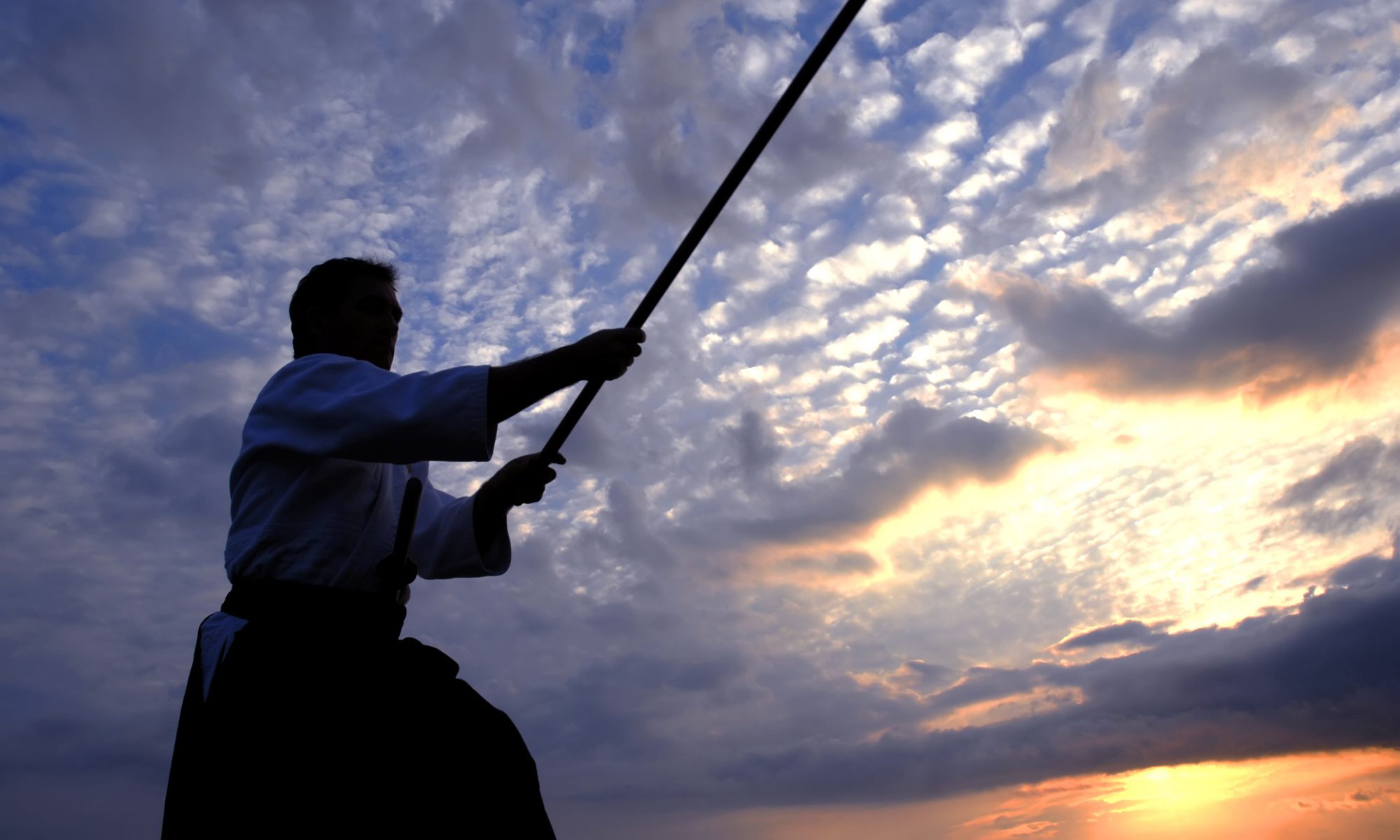COMMON WORDS
AIKIDO
(Eye-key-doe)
Ai = harmony, Ki = spirit, Do = The Way or Path
AIKI TAISO
(Eye-key-tie-so)
Aikido Exercises
ATEMI WAZA
(Ah-the-me Wah-zah)
Striking Techniques
BOKKEN
(Bow-ken)
Wooden sword used in practice
BUSHIDO
(Boo-she-doe)
Warrior’s Code. The way of the warrior
DAN
(Dawn)
Aikido grade holder, black belt rank
DESHI
(Day-she)
Student, pupil, disciple
DOJO
(Doe-joe)
Training hall (formally a term used by Buddhist priests in reference to their place of worship)
DOSHI
(Doe-she)
Comrade, friend (used among fellow aikidoists)
GAESHI – (Spelled Kaeshi when not proceeded by another word)
(Guy-eh-she)
To reverse
GI
(Ghee)
Training costume
HAKAMA
(Hawk-ah-ma)
A 7 pleated divided, pant-like skirt
HANMI
(Hawn-me)
A posture in which one foot is advanced one step and the body weight is distributed equally on both feet — Also known as a triangular stance
HANMI HANDACHI
(Hawn-me Hawn-dah-chee)
Nage (thrower) is kneeling and uke (the attacker) approaches from a standing position
HANTAI
(Hawn-tie)
In reverse order
HARA
(Har-ah)
The center of existence — Lower abdomen, physical and spiritual center
HIDARI
(He-dah-ree)
Left (direction)
HIJI
(He-gee)
Elbow
Irimi
(Ee-ree-me)
To enter; entering
JIYU
(Gee-you)
Free style
JIYU WAZA
(Gee-you Wah-zah)
Free style techniques/practice
JO
(Joe)
Wooden staff
KAITEN
(Kaiten)
To revolve or rotate
KATA
(Kah-tah)
Shoulder — Also means ‘form’– practice of pre-arranged exercise(s)
KATATE
(Kah-tah-tay)
One hand (left or right)
KEIKO
(Kay-ko)
Practice session; training
KEN
(Ken)
Japanese sword
KI
(Key)
Spirit…the vital force of the body; Universal Energy; A stream or flow of positive energy
KIAI
(Key-eye)
A piercing scream or cry with practical and psychological value meaning – “Meeting of the Spirits”
KOKYU
(coke-you)
Breath power…the coordination of ki flow with breathing
KOKYU DOSA
(Coke-you Doe-sah)
A method of off-balancing and pinning your partner with youR ‘KI’ instead of with your physical power
KOSHI
(Ko-she)
Hips, waist (also spelled Goshi)
KUBI
(Coo-bee)
Neck
KYU
(Cue)
Aikido rank, class — A mudansha or undergraduate
MAAI
(Mah-eye)
Distance between uke and nage — meaning “harmony of space”
MEN
(Men)
Face, head
MIGI
(Mee-ghee)
Right (direction)
NAGE
(Nah-gay)
Throw…the person who throws
OBI
(Oh-bee)
Belt
O’SENSEI
(Oh-sen-say)
The great teacher, (Morehei Ueshiba)
RANDORI
(Ran-door-ri)
Multiple attack
REI
(Ray)
Salutation, bow
RYOTE
(Ree-oh-tay)
Both hands
SAMURAI
(Sam-oh-rye)
Military retainer (feudal period)
SEMPAI
(Sem-pie)
Senior student
SENSEI
(Sen-say)
Teacher, instructor
SEIZA
(Say-zah)
Formal sitting posture
SHIHO
(She-ho)
Four directions
SHIHAN
(She-han)
Master Teacher
SHIME
(She-me)
To choke
SHODAN
(Show-Dawn)
Holder of the first grade black belt
SHOMEN
(Show-men)
Front or top of the head
SUBURI
(Sue-boo-ree)
A single movement using the ken or jo done as a solo practice
SUTEMI
(Sue-the-me)
A hard fall…literally meaning to throw or sacrifice the body
SUWARI WAZA
(Sue-wah-ree Wah-zah)
Sitting techniques
TACHI
(Tah-chee)
Japanese sword
TACHI DORI
(Tah-chee Doe-ree)
Techniques of taking an opponents’ sword
Taijutsu
(Tie-jut-sue)
Body arts — The techniques of Aikido done without weapons
TAI NO HENKO
(Tie-no-hen-ko)
Basic blending practice
TANTO
(Tahn-toe)
Wooden knife
TE
(Tay)
Hand
TEGATANA
(Tay-gah-tah-nah)
Hand blade — Sword edge of the hand
TE KUBI
(Tay-koo-be)
Wrist
TENCHI
(Ten-chee)
Ten = heaven, Chi = earth — A position of the hands, one high (up) and one low (down)
TSUKI
(Tski)
Thrust
UCHI
(Ooh-chee)
To strike
UKE
(Ooh-kay)
Generally speaking, a person who receives an attack,
UKEMI
(Ooh-kem-me)
Breakfall — The art of falling away from harm
USHIRO
(Ooh-she-row)
Back — behind — rear
WAZA
(Wah-zah)
Techniques
YOKOMEN
(Yoh-ko-men)
Side of the head
YUDANSHA
(You-dawn-sha)
Black belt grade holder(s)
HELPFUL PHRASES
OHAYO GOZAIMASU
(Ohio go-zah-ee-mahs)
“Good morning.” (used before 10am)
KONNICHI WA
(Kone-knee-chee wah)
“Hello!” or “Good day.” (after 10am)
KOMBAN WA
(Comb-bahn wah)
“Good evening.”
OYASUMI NASAI
(Oh-yah-sue-me nah-sigh)
“Good night.” (before bedtime)
SAYONARA
(Sigh-yoh-nah-rah)
“Good-bye.”
ARIGATO GOZAIMASU
(Ah-ree-gah-toe go-zah-ee-mahss)
“Thank you.”
SENSEI, DOMO ARIGATO GOZAIMASHITA
(Sen-say, doe-moe ah-ree-gah-toe go-zah-ee-mah-she-tah)
“Sensei (teacher), thank you very much for what you have done.” — spoken by students at the end of aikido class
ONEGAI SHIMASU
(Oh-nigh-guy-she-mahss)
“I make a request.” — spoken when one wishes to practice with a fellow student or teacher
SUMIMASEN
(Go-men nah-sigh)
“I’m sorry, excuse me.”
DO ITASHIMASHITE
(Doe ee-tah-she-mah-she-tay)
“Don’t mention it. You’re welcome.”
OGEN’KI DESU KA
(Oh-ghen-key des-kah)
“How are you? Are you in good spirits?”
OKAGESAMA DE
(Oh-kah-ghe-sama day)
“Fine, thank you.”
HAJIMEMASHITE
(Haji-may-mah-she-tay)
“How do you do?” — When introduced to someone for the first time

